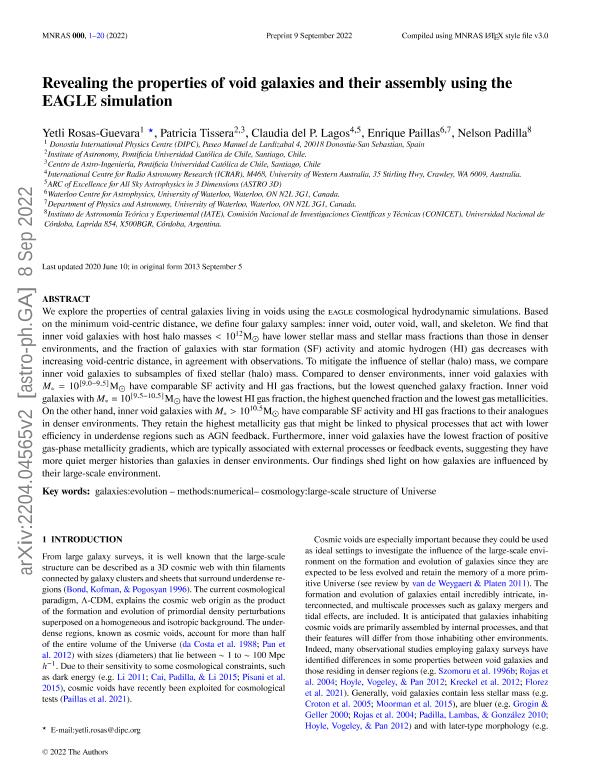Mostrar el registro sencillo del ítem
dc.contributor.author
Rosas Guevara, Yetli
dc.contributor.author
Tissera, Patricia Beatriz

dc.contributor.author
Lagos, Claudia del P
dc.contributor.author
Paillas, Enrique
dc.contributor.author
Padilla, Nelson David

dc.date.available
2023-07-10T14:37:31Z
dc.date.issued
2022-11
dc.identifier.citation
Rosas Guevara, Yetli; Tissera, Patricia Beatriz; Lagos, Claudia del P; Paillas, Enrique; Padilla, Nelson David; Revealing the properties of void galaxies and their assembly using the eagle simulation; Oxford University Press; Monthly Notices of the Royal Astronomical Society; 517; 1; 11-2022; 712-731
dc.identifier.issn
0035-8711
dc.identifier.uri
http://hdl.handle.net/11336/202960
dc.description.abstract
We explore the properties of central galaxies living in voids using the EAGLE cosmological hydrodynamic simulations. Based on the minimum void-centric distance, we define four galaxy samples: inner void, outer void, wall, and skeleton. We find that inner void galaxies with host halo masses <1012M⊙<1012M⊙ have lower stellar mass and stellar mass fractions than those in denser environments, and the fraction of galaxies with star formation (SF) activity and atomic hydrogen (H I) gas decreases with increasing void-centric distance, in agreement with observations. To mitigate the influence of stellar (halo) mass, we compare inner void galaxies to subsamples of fixed stellar (halo) mass. Compared to denser environments, inner void galaxies with M∗=10[9.0−9.5]M⊙M∗=10[9.0−9.5]M⊙ have comparable SF activity and H I gas fractions, but the lowest quenched galaxy fraction. Inner void galaxies with M∗=10[9.5−10.5]M⊙M∗=10[9.5−10.5]M⊙ have the lowest H I gas fraction, the highest quenched fraction and the lowest gas metallicities. On the other hand, inner void galaxies with M∗>1010.5M⊙M∗>1010.5M⊙ have comparable SF activity and H I gas fractions to their analogues in denser environments. They retain the highest metallicity gas that might be linked to physical processes that act with lower efficiency in underdense regions such as AGN (active galaxy nucleus) feedback. Furthermore, inner void galaxies have the lowest fraction of positive gas-phase metallicity gradients, which are typically associated with external processes or feedback events, suggesting they have more quiet merger histories than galaxies in denser environments. Our findings shed light on how galaxies are influenced by their large-scale environment.
dc.format
application/pdf
dc.language.iso
eng
dc.publisher
Oxford University Press

dc.rights
info:eu-repo/semantics/openAccess
dc.rights.uri
https://creativecommons.org/licenses/by-nc-sa/2.5/ar/
dc.subject
Galaxies
dc.subject
Simulations
dc.subject.classification
Astronomía

dc.subject.classification
Ciencias Físicas

dc.subject.classification
CIENCIAS NATURALES Y EXACTAS

dc.title
Revealing the properties of void galaxies and their assembly using the eagle simulation
dc.type
info:eu-repo/semantics/article
dc.type
info:ar-repo/semantics/artículo
dc.type
info:eu-repo/semantics/publishedVersion
dc.date.updated
2023-07-06T11:31:20Z
dc.journal.volume
517
dc.journal.number
1
dc.journal.pagination
712-731
dc.journal.pais
Reino Unido

dc.journal.ciudad
Oxford
dc.description.fil
Fil: Rosas Guevara, Yetli. Pontificia Universidad Católica de Chile; Chile
dc.description.fil
Fil: Tissera, Patricia Beatriz. Consejo Nacional de Investigaciones Científicas y Técnicas. Centro Científico Tecnológico Conicet - Córdoba. Instituto de Astronomía Teórica y Experimental. Universidad Nacional de Córdoba. Observatorio Astronómico de Córdoba. Instituto de Astronomía Teórica y Experimental; Argentina. Pontificia Universidad Católica de Chile; Chile
dc.description.fil
Fil: Lagos, Claudia del P. Pontificia Universidad Católica de Chile; Chile
dc.description.fil
Fil: Paillas, Enrique. Pontificia Universidad Católica de Chile; Chile
dc.description.fil
Fil: Padilla, Nelson David. Consejo Nacional de Investigaciones Científicas y Técnicas. Centro Científico Tecnológico Conicet - Córdoba. Instituto de Astronomía Teórica y Experimental. Universidad Nacional de Córdoba. Observatorio Astronómico de Córdoba. Instituto de Astronomía Teórica y Experimental; Argentina
dc.journal.title
Monthly Notices of the Royal Astronomical Society

dc.relation.alternativeid
info:eu-repo/semantics/altIdentifier/url/https://academic.oup.com/mnras/article/517/1/712/6696385
dc.relation.alternativeid
info:eu-repo/semantics/altIdentifier/doi/https://doi.org/10.1093/mnras/stac2583
dc.relation.alternativeid
info:eu-repo/semantics/altIdentifier/arxiv/https://arxiv.org/abs/2204.04565
Archivos asociados
